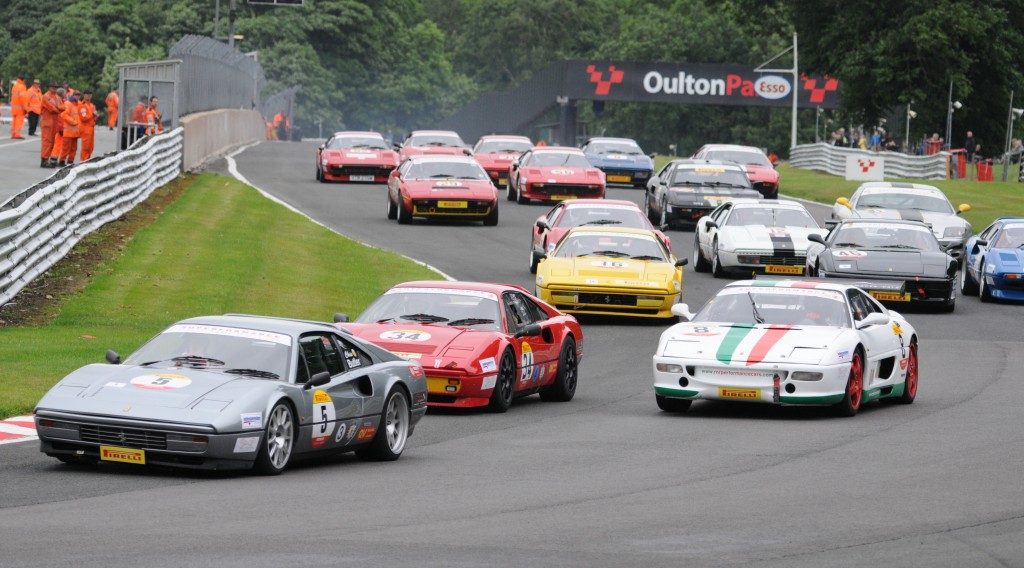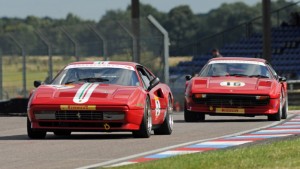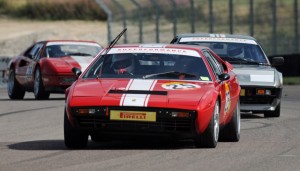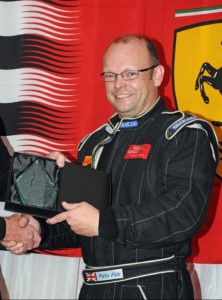Getting Started

These notes are primarily intended for drivers who are maybe just starting out on the circuits with their Ferraris and would like to know something about the Ferrari Owners’ Club’s race series: the Pirelli Ferrari formula classic (PFfc). They may have previously competed in races or hillclimbs, taken part in the Club’s track days, or even have simply read about the race series and fancy having a crack themselves. Whatever the level of experience, this brief guide has been produced to give essential information that is needed to understand what the two series are all about and the things competitors must do before they can take part. The series is open to Ferrari production tipos introduced prior to 1997 (i.e. before the introduction of the 360 Modena).
To make the notes more digestible, they have been written in the form of FAQs.
What do I need to get started?
All competitors in any form of motorsport in this country must have an MSA competition licence. For PFfc the minimum grade of licence is Race National B, which currently costs £60.00. However, if you take part in races overseas the MSA requires drivers to have a Race National A licence, for which the charge is £94.00.
If you already have a National B licence this can be upgraded at any time, once you have obtained the required number of Clerk of the Course signatures from previous races, on payment of the difference in cost between the licences plus an additional £34.00.
In order to obtain your licence you must first apply to the MSA for a novice race driver’s ‘Go Racing Driver Pack’. The contact details for the MSA are: Motor Sports Association, Motor Sports House, Riverside Park, Colnbrook, SL3 0HG. T: 01753-765000. Their website is at www.msauk.org . The Club has a few ‘Packs’ in stock or alternatively you can get one from Demon Tweeks or GP Racewear.
Armed with the ‘Pack’ (currently £99.00) you must then complete an approved course at a school registered with the Association of Racing Drivers’ Schools (ARDS). Full instructions are contained in the ‘Pack’. The cost of the course is around £320.00 depending on the school used and additional coaching required etc..
The course, which takes about 2 hours, consists of a written exam and driver assessment. The aim is to make sure that you’re proficient and safe to be let out among other drivers. If you have studied the video and other literature that comes with the ‘Pack’ you should breeze through it. It’s multiple choice, mainly about flags and procedures, but you do have to get 100% to pass.
In the driving assessment you will be driven for a few laps (in the school’s car, not your Ferrari) by an instructor and then you’ll take over. He will be looking for smooth driving, not lap record breaking pace. If he’s happy and you have passed the written exam then he’ll tick the relevant box that will allow you to send off for your licence and your weekends will never be the same again.
There is one further thing that you must do before a race licence can be issued and that is to get through a simple medical examination. This can be carried out by you own GP although he is entitled to make a charge, usually upwards of £50.
I’ve got my licence — now what?
You need to apply to Steve Burns, the Race Coordinator for the series, for an invitation from the Ferrari Owners’ Club to register to take part.
Steve will send you all the necessary paperwork including a copy of the current Regulations. You will need to complete a Registration form and submit this, together with the Registration fee, currently £275 for the season.
Once registered for the series you you will be given your own permanent competition number, and a set of decals with instructions on where these are to be affixed to your car.
What do I need to do to my Ferrari to make it suitable for the track?
Very little really. To conform to MSA regulations there are a number of safety features that need to be fitted. An external ignition cutout switch must be incorporated in the electrical circuit so that marshals are able to switch off the engine in an emergency. This is straightforward to do and for a mid engined Ferrari can be located under the front bonnet with a discreet pull cable between the body panels and identified by an appropriate label.
The car must be fitted with substantial towing eyes front and rear of a particular specification which need to be clearly identified.
A 4 or 6 point harness must be fitted, again easily achieved without spoiling the interior of the cabin and able to be removed at a later date if you wish. A good quality harness can be purchased for around £200 and you will find that when properly tightened up will prevent you having to brace yourself in corners. Fitting a proper racing seat is also sensible; it will hold you in position far better than the standard slippery leather seat and in my opinion is worth about a second a lap.
All cars used for racing must be fitted with an approved rollover protection system (ROPS). We have made arrangements with a number of ROPS manufacturers who can carry out the work and the Race Coordinator will be pleased to give all the necessary details, including prices, on application.
All cars engaged in circuit racing must be fitted with a plumbed in fire protection system and the requirements are listed in the MSA Blue Book. Systems complying with the regulations start at around £200 for a mechanical setup (electrically operated models are around £250 more).
In times of bad visibility competitors are usually instructed to switch on their lights which include a rearward facing high intensity fog light. If your Ferrari is fairly recent it may have an acceptable one already installed. If not you will need to fit one.
The final item you will need to fit is a transponder. This device sends signals back to the timekeepers to enable them to time each lap and log your position in the race. These are supplied by TSL Timing Solutions Ltd, who do most of the timing at the circuits, and an order form can be downloaded from their website at www.tsltiming.com It is strongly advised that you purchase one that is wired into the electrical circuit (battery ones are available but are notorious for going flat at exactly the wrong time!). The current price is £168 including a one year subscription, with subsequent annual subscriptions at £ 48 per year.
After fitting the bits and pieces you have mentioned, is there anything else I must do to the car?
 To make sure your car is doing the best possible job for you, see that it’s properly checked and fully serviced. Hydraulic oil has a limited life and is hygroscopic i.e. absorbs water. The braking system should therefore be drained and replaced with fresh fluid, preferably one with a higher boiling point than normal. AP and Castrol racing fluid is ideal and should obviate any overheating problems. The demands on the brakes are much more severe than those experienced in road use and therefore it is a good move to fit high performance pads more suited to the task.
To make sure your car is doing the best possible job for you, see that it’s properly checked and fully serviced. Hydraulic oil has a limited life and is hygroscopic i.e. absorbs water. The braking system should therefore be drained and replaced with fresh fluid, preferably one with a higher boiling point than normal. AP and Castrol racing fluid is ideal and should obviate any overheating problems. The demands on the brakes are much more severe than those experienced in road use and therefore it is a good move to fit high performance pads more suited to the task.
Various companies produce excellent race pads which warm up quickly, are easy on the discs, and should give virtually fade free performance in racing conditions. They also work well in road use so you don’t have to keep changing them. For technical advice we suggest that you contact one of the many excellent preparers who have been involved in the series over many years.
What tyres should I use?
Tyres used in the series must be of Pirelli manufacture. Tyres are supplied from Protyre Motorsport on behalf of Pirelli and advice and expertise is freely available. Contact Protyre on 01782 411001.
All cars in the PFfc race on treaded tyres conforming to those listed in the MSA Blue Book. Tyres must be in accordance with the series Regulations and have a minimum of 1.6mm of tread at the start of the race.
Pirelli make what many regard as the best range of suitable tyres which, whilst road legal (as required by the rules), afford a degree of grip only dreamt about not too many years ago. Presently our control tyres are the excellent PZero TrofeoR.
What do I need in the way of special clothing?
It is obligatory to wear an approved fire resistant race suit and an MSA sanctioned helmet bearing a valid date sticker. A HANS device (head restraint) is also mandatory and fireproof underwear will be required. Add a balaclava, boots and gloves and you are instantly a race driver! Not exactly cheap but the cost will be spread over five or more years.Suppliers such as Demon Tweeks and Grand Prix Racewear list a wide range of products to suit all pockets.
Do I need to have had previous race experience?
No, although you must, of course, be a competent driver and have some knowledge of what driving on a circuit is all about. These qualities should have been demonstrated when you did your ARDS course. Today there is much on-line coaching available via web sites like Scott Mansell’s driver 61, plus youtube has a wealth of in-car footage to get tips from. Check out our own video channel for formula classic in-car footage.
One thing worth saying is that you mustn’t expect to be leading the field on your first outing. Don’t be despondent if your speed is significantly slower than the leading drivers in your class. With experience the abilities of most drivers improve tremendously and the standard of driving of the front running Ferrari competitors is now very high indeed.
It should be your target to eventually match these skills which only experience can achieve. As your proficiency improves you will be amazed how much quicker you will become, and with far less drama. And a bonus will be that you will become a far better and safer driver on public roads.
How important is physical fitness?
As with most sporting activities, fitness cannot fail to improve your performance. As mentioned earlier, to obtain your licence all competitors must pass a simple medical examination, annually if over 45. If you move up from a National licence to International (not strictly necessary but some of our drivers have International documents for racing abroad), the medical requirements are rather more demanding, including a stress related ECG every second year. We can confirm that this test is plain sailing providing you can put up with the cold hands of the ECG machine’s operator.
Having satisfied these medical criteria it is safe to assume that your general health and eyesight (with glasses or contact lenses if necessary) are satisfactory and good enough to drive a race car on the track. As most of the races in the series don’t exceed about 18 laps or 30 minutes duration, the cockpit temperatures don’t become tremendously high as they might do in a stint in the Le Mans 24Hour race. Nevertheless there are a number of drivers who make serious efforts to ‘fight the flab’ and seem to be fitter and arguably faster as a result.
Age is no handicap to racing in the PFfc series, and there are a number of ‘old hands’ (your scribe should know!) who enjoy their racing just as much as their younger rivals.
What about the risk of mechanical failure or having an accident?
 Ferraris are very strong cars and built to the highest standards, so the incidence of serious mechanical failure is very low indeed. The occasional problems that do occur are usually due to poor maintenance and shouldn’t happen if the cars are properly looked after.
Ferraris are very strong cars and built to the highest standards, so the incidence of serious mechanical failure is very low indeed. The occasional problems that do occur are usually due to poor maintenance and shouldn’t happen if the cars are properly looked after.
In the twenty years we have run the forerunner of the PFfc and PFO series, the Pirelli Maranello Ferrari Challenge, there were no instances whatsoever of serious injury. Whilst motor racing, by its very nature, cannot be wholly without accident risk, racing in the our series is probably safer than taking part in the average track day.
The Club takes driver behaviour on the circuit very seriously indeed. With huge experience of running race championships we have systems in place that make sure, as far as is possible, that drivers have a proper respect for their fellow competitors and their Ferraris. We have a strictly enforced Code of Conduct and when necessary we make use of incar cameras. Any instances of unacceptable or unsportsmanlike behaviour is dealt with positively albeit fairly.
Driver briefings are invariably arranged at each circuit and an opportunity given for drivers to get expert advice and have any queries answered. Beginners especially are given all the help that they need.
Do I have to drive my race Ferrari to the circuit?
In order to comply with the Regulations, certain classes of Ferraris that take part in the PFfc series must be able to pass the MOT examination and therefore, since they are fitted with roadlegal treaded tyres, they should be able to be driven to the circuit. However, it is recognised that because there is a certain amount of gear which competitors may wish to take with them to the races — tools, fuel cans, oil, a jack, signalling board, spare tyres or wheels, etc — it is more convenient to put the car on a trailer rather than drive the Ferrari on the road and bring a second vehicle (which of course requires a second driver).
The advantages of using a trailer are that if you have any misfortune with your race car you can always get home without help from the AA or RAC, and you can share the journey with your loved one instead of travelling in silence on your own.
Having said that the use of trailers is acceptable, there are a number of competitors who drive their race car to the events. They will continue to have our admiration because they really reflect the true spirit of the PFfc.
Is the cost of racing in the Ferrari series prohibitively expensive?
 By comparison with other onemake series, costs are surprisingly modest. Like most things, what you spend is to some extent what you want to make it. If you insist on professionals doing all the work on your car at commercial rates your bill at the end of the season will be very much higher than it would be if you tackle some of the jobs yourself. I am a firm believer in the dictum that the more you put in yourself, the more satisfaction you will get out. I am sure that drivers who do some of the work on their car themselves derive more enjoyment out of their motor racing than those who simply turn up and drive.
By comparison with other onemake series, costs are surprisingly modest. Like most things, what you spend is to some extent what you want to make it. If you insist on professionals doing all the work on your car at commercial rates your bill at the end of the season will be very much higher than it would be if you tackle some of the jobs yourself. I am a firm believer in the dictum that the more you put in yourself, the more satisfaction you will get out. I am sure that drivers who do some of the work on their car themselves derive more enjoyment out of their motor racing than those who simply turn up and drive.
Having said that, not all of us have the skills or facilities to, say, build an engine or overhaul a gearbox. But it is quite within most competitors’ abilities to check and change brake pads, drain and replenish oils, spanner check the chassis, switch wheels, etc. By doing these routine tasks yourself the savings over a season can be quite substantial.
There are certain fixed costs to meet at every event: transport to and from the circuit, fuel and oils, accommodation where necessary, and the race entry fee. The tyres in PFfc should last at least most of a season (they are quite a bit harder than racing slicks) and the life of the brake pads, particularly the rears, is likely to be for a season. Unless you are particularly unfortunate it is unlikely that the bills from your preparer will be significantly more than you would have spent anyway on routine servicing and overhauls.
So you can almost work out your budget on the back of a (small) envelope before you start.
Is there anything I need to know about procedures at the race meetings?
On the day of the race there are several things you will need to be aware of.
The timetable for the event will be sent to you in advance by the race organisers in the form of ‘Final Instructions’. These will tell you where you are located in the paddock and the times of signingon, scrutineering, qualifying and the race. They should also indicate the time and whereabouts of any briefings. Any competitor who hasn’t raced before at that particular circuit will need to attend a special newcomers’ briefing before being allowed out on the track.
The first thing to do on arrival is to signon with the race organisers and for this you will need your MSA competition licence and Club membership card. Without the former there is no way you will be permitted to race so make sure you don’t leave it on the kitchen table!
You will then need to take your car to the scrutineering bay at the appointed time. Don’t go before this time because all you will do is snarl up the procedure and drivers in other races, who are due to qualify in sessions ahead of you, will be delayed. At the same time as general safety scrutineering is being carried out by the organisers’ officials, our own Eligibility Scrutineer, Andy Bush, will usually carry out his own checks on your vehicle’s compliance with our Regulations.
The scrutineers will wish to see your helmet and race suit to make sure they have a valid certification, so make sure you have these with you. They will also satisfy themselves that your transponder is working properly. If everything is ticketyboo they will issue a ‘pass’ sticker which you need to affix to one of the side windows on your car so that marshals can readily see that your vehicle has been approved to take part.
Make sure that you keep your ears open for summons to briefings. Newcomers are usually given a choice of briefing times but it is mandatory to attend them. Similarly, if there is a special briefing for the Ferrari competitors it is essential to attend it, on pain of being excluded from taking part or perhaps having to pay a fine. You have been warned!
Apart from all this, you simply need to be ready when the time comes to take your car to the assembly area. It is a good plan to have a check list of vital tasks, which might include reminders to check petrol (it wouldn’t be the first time that a Ferrari driver has failed to finish a race because he forgot to refuel after qualifying), tyre pressures, water and oil levels, and even a visit to the loo!
from all this, you simply need to be ready when the time comes to take your car to the assembly area. It is a good plan to have a check list of vital tasks, which might include reminders to check petrol (it wouldn’t be the first time that a Ferrari driver has failed to finish a race because he forgot to refuel after qualifying), tyre pressures, water and oil levels, and even a visit to the loo!
Most of your fellow competitors will have vivid memory of the excitement of their first race and should you ask anyone you can be sure that you will get a helping hand in getting through these procedures.
OK! I want to go racing and you’ve convinced me that I can do it. What do I do now?
Contact our Race Coordinator, Steve Burns, right away at:
Cavallino House
2 Church Way
Whittlebury
Nothamptonshire NN12 8XS
tel: 07701 004 694
Steve.Burns@ferrariownersclub.co.uk
Steve will be pleased to send you all the paperwork you need, including the 2015 Regulations and a Registration form.












